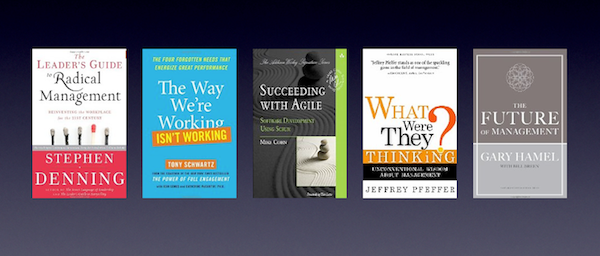Project Collaboration Overview & 7 Great Books : Siemens Talk
Posted on 12. Mar, 2013 by ger in Agile, Events, Guides, Leadership, New Ways to Work, blog
Last night in Dublin I spoke to a group leaders from Siemens at an event coordinated by WDHB.
The key points of my talk were:
- Existing tools still don’t solve the problems of communication within large organizations
- Businesses need a flexible system that can scale from gigantic to many small-informal projects
- Culture is even more important than tools. Agile ways of working & leading with short iterations and empowered teams are crucial.
I recommended a number of books that explore the last point:
- Radical Management: Stephen Denning
- Succeeding with Agile: Mike Cohn
- The Future of Management: Gary Hamel
- Management 3.0: Jurgen Appelo
- Getting Things Done: David Allen
- The Way We’re Working isn’t Working: Tony Schwartz
- What Were They Thinking?: Jeffrey Pfeffer
Other speakers at the event were Marie Wallace of IBM and Polly Sumner of Salesforce. Polly recommended a really interesting followup action at end of her talk. She suggested everyone in the room try to buy or get customer support for their own product.
By coincidence I read the following quote in the Siemens “Pictures of the Future” magazine this morning.
-
“Modern information and communication media promote a short attention span and a superficial understanding of the world.” — David Gelernter.
By another coincidence I read this in the Chess Media newsletter this morning.
-
“Communication barriers cost large companies an average of $26,000 per employee per year due to productivity losses.” — Jacob Morgan
Learn more
Try Goshido, our collaboration & project management platform. Goshido is so flexible it can be used for project collaboration in any kind of business: product development, energy, healthcare & consulting.
You can download my slides.
The Business Value in Becoming an Agile Enterprise
Posted on 29. Feb, 2012 by ger in Leadership, New Ways to Work

In the last few weeks I’ve been asked the same two questions a number of times:
- Does this agile stuff really make a difference in financial terms?
- We don’t do software development, does agile really apply to us?
In this post, I’ll answer these questions (the short answers are yes and yes). I’ll tell you three short stories. Two stories quantify the benefits of agile. The final story is about a team who uses agile to run marketing campaigns.
What’s in it for us?
Michael Mah in “How Agile Projects Measure Up, and What This Means to You” analyzes two software projects. He compares their performance to projects of similar sizes from a large project-performance database. The projects measured lower costs, shorter time-to-market, and increased quality.
Follett Software used a technique called eXtreme Programming and achieved:
- Dramatically lower costs ($2.2m versus an average of $3.5m for similar sized products)
- Shorter time-to-market (7.8 months versus an average of 12.6 months)
- Less defects (121 versus 242)
BMC Software used Distributed Scrum. They added more staff (92 versus 40 average) to optimize time-to-market. They achieved:
- Dramatically shorter time-to-market (6.3 months versus an average of 15 months)
- Slightly lower costs ($5.2m versus an average of $5.5m for similar sized products). The extra cost of staff was offset by much shorter project duration.
- Slightly less defects (635 versus 713)
These are just two specific examples. David Rico completed a much larger meta-study looking at a large number of projects (which referenced a paper published in the EJIS that I co-authored with Brian Fitzgerald and Kieran Conboy).
Agile beyond software development: a retail marketing campaign
One of our customers decided to apply agile on retail marketing campaigns across 13 European countries.
Before agile they organized everything quarterly. Every quarter their campaigns had a number of open issues that spilled over and took time to resolve the following quarter. The backlog of open issues was ever increasing and pressure was mounting every quarter.
When they applied agile they split the teams into smaller units of 5 people or less. They ran projects in shorter iterations (monthly sprints instead of three month iterations). They observed a number of key benefits:
- Very few issues spilled over from one quarter to the next
- They were able to eliminate the historical backlog
- Team morale improved dramatically
Again this is one specific example. Stephen Denning has written an excellent book “The Leaders Guide to Radical Management” about applying agile principles to management in all kinds of businesses.
Learn more
If you’re a time-pressed business person, read Israel Gat’s short book “The Concise Executive Guide to Agile”. He gives a good overview of agile that focuses on the numbers and how to introduce agile in your enterprise.
If you’re based in the UK, “The Agile Leader” is a team of consultants and coaches who deliver Agile transformation to organisations.
Try Goshido, our collaboration & project management platform. Goshido is so flexible it can be used for projects in any part of your organization.
Photo Credit
Five principles to improve productivity, reduce churn & increase profits
Posted on 18. Nov, 2011 by ger in Leadership, New Ways to Work

Five books describing a new approach to business
There’s a revolution happening in the way businesses are being run. This post will distill five key principles of this transition from five “new approach” business books. These principles will help you increase productivity, reduce staff turnover and increase profits.
Many books and blog posts have been written about this new approach to business. Many present case studies from companies like Apple, Best Buy, Enterprise, Semco, Salesforce, and WL Gore. The Whole Foods Market story is profiled in Gary Hamel’s “The Future of Management”.
The Whole Foods Story
Whole Foods Market is made up of many empowered teams. Each team:
- Has autonomy and is in essence a small business inside the store
- Has freedom but is held accountable
- Transparently publishes their performance (profit/hour)
- Can veto new hires
- Can decide what to stock
Each store is benchmarked 10 times a year. The pressure to perform comes from peers not managers. This non-hierarchical structure means decision making is distributed and small problems don’t fester before being noticed and addressed.
While this might sound new-age and chaotic, Whole Foods Market is the most profitable food retailer in the US (per sq foot). Whole Foods Market rallies around a clear purpose. “We want to improve the health and well-being of everyone on the planet through higher quality foods and better nutrition. We can’t fulfill this mission unless we are highly profitable.”
Other Success Stories
Other companies have made similar radical transitions and seen performance improvements:
- Salesforce switched their product development to agile and increased productivity by 38% and doubled their revenues over a two year period
- WL Gore has $2B in revenues and has been run as an innovation democracy for 40 years
- Best Buy started a “results only work environment” and increased productivity by 41% and reduced staff turnover costs by 90%
- Thogus Products a small manufacturing company increased output 67%
These revolutionary techniques come labelled in many ways: radical management, future management, agile businesses and protean organizations. Whichever label you choose, companies that use these techniques are surviving and prospering. Companies who stick to the old techniques of cost cutting, salary reductions and layoffs lose productivity, customers and frequently enter a downward spiral from which recovery is extremely difficult.
The key principles
Empowered teams of engaged individuals
Scott Page studied groups solving complex problems and found a cognitively diverse group of people outperforms a group of like minded experts. Teams which are given autonomy and control perform better. When people at the grassroots of the organization have a clear line of sight to customers they can see how they are contributing to the organizations goals.
Delivering true customer value
Unhappy clients can damage a brand. People with a line of sight to the customer feel more motivated. The meaning of their work is not the toy they’re assembling or the profit the company will make, but the delight on the face of a child. Companies like Enterprise have used net promotor scores to delight customers and turnaround their business. In contrast, David Carroll’s YouTube video “United breaks Guitars” has been watched over 11 million times (at the time of writing).
Using short iterations value adaptability over predictability
Projects with long timelines and complex Gantt charts repeatedly miss budgets and deadlines. The iterative approach was used to great success on Polaris submarine program in the 1950’s and 1960’s. By reducing the amount of work in progress and breaking large projects down into four weeks long or smaller iterations, teams can become far more effective.
Information radiators
Lack of management transparency has resulted in a number of disasters. Problems are brushed under the carpets. Well-meaning questioning is rooted out as dissent. When teams create dashboards to show progress there’s no need for status reports. Anyone can see information about the project. The best performing organizations have universal accountability.
Introspection and action
It’s hard to imagine how stopping a production line for a defect could be a good idea, but it is. The team must first recognize reality and the issues that exist but that’s less than half the battle. Taking remedial action is usually the hard part. Changing people’s behavior to fix systemic issues is even harder.
- “Implementing continuous self-improvement requires a fundamentally different kind of mind-set from traditional management. It involves creating an environment in which the organization draws on the full talents and capacities of the people who work there… It’s about powering up the internal energy of teams so that they transcend their limitations and create products or services that generate client delight.” – Stephen Denning
The time to act is now
Maybe you’re thinking “yes this is important, we’ll do something about it soon.” Maybe you’re too busy. If your business is not improving it’s standing still. Companies who delay will: miss opportunities, lose customers, and be outmaneuvered by nimble competitors.
Learn more
Thank you for reading. We hope you found something useful. Please try Goshido, our collaboration & project management platform. Goshido can help you and your teams to apply new business principles to improve productivity.
If your company is an Enterprise Ireland client you can avail of training and support to introduce Lean and Agile techniques to your business.
Some books we recommend
Here are links and summaries to some great books on the “new approach” to business.
Stephen Denning’s book The Leader’s Guide to Radical Management applies agile techniques to the organization as a whole, not just a single team or the product development group. Denning translates Agile and Scrum from software development into general business terms.
The Way We’re Working Isn’t Working by Tony Schwartz, Jean Gomes and Catherine McCarthy creates a road map for a new way of working. At the individual level, they explain how we can build specific rituals into our daily schedules. At the organizational level, they outline new policies and practices that energize great performance.
In Succeeding with Agile, Mike Cohn describes success factors in applying an agile technique called Scrum in your organisation. It is mainly written from a software development perspective but there’s some valuable suggestions on team dynamics and the need for enlightened leadership. Chapters 10 and 12 describe the mind shift needed to become a “servant leader” of self-organizing teams.
Gary Hamel in The Future of Management makes the case that management innovation fuels long-term business success. He profiles a number of companies who have successfully reinvented management for their organizations.
In What Were They Thinking?: Unconventional Wisdom About Management, Jeffrey Pfeffer describes conventional business wisdom and the problems it can cause. He focuses on three common themes: understanding feedback effects, self-managing teams, and avoiding overcomplication.
The Four Principles of Leadership
Posted on 20. Sep, 2011 by tom in Leadership
In a recent post “The Monk and the Knowledge Worker” Donal told an old story about a Buddhist monk. Now it’s time to tackle some leadership lessons from another “old company,” this time the Jesuits.

In his book Heroic Leadership, Chris Lowney analyzes what he calls the four pillars of success:
- Self-awareness: understand your strengths, weaknesses, values, and worldview
- Ingenuity: confidently innovate and adapt to a changing world
- Love: engage others with a positive attitude that unlocks their potential
- Heroism: energize yourself and others with heroic ambitions and a passion for excellence
As you might expect from an author who is both a former Jesuit and investment banker, the lessons from the book manage to be both manifold and on-point for the challenges we face in business today. If you think cracking China is hard today, imagine how hard it was four centuries ago? But using their core leadership principles, the Jesuits managed achievements that were truly heroic.
Stripping away any positive or negative biases, the lessons of the Jesuits can be seen in the works of experts as diverse as Peter Drucker or Daniel Goleman. Drucker on the knowledge economy and worker, and Goleman on managerial self-awareness (his 5 core competencies: self-awareness, self-regulation, motivation, empathy, and social skill).
Working in a world with lots of everyday distractions (aka information overload) awards a high value to those who can effectively tune out those distractions and focus on the key goals at hand. One way to make ambitious goals manageable is to break them down into smaller goals. Lowney even invokes the challenge of kicking a smoking habit, the same metaphor captured in the title of David Maister’s wonderful book “Strategy and the Fat Smoker.”
We spend so much time looking forward in business today that sometimes we forget that there’s still much to be learned by looking back. Clearing the clutter – understanding clearly what you need to do and what you need to know – can free you to be more productive, and perhaps even heroic.
Reading list:
- Chris Lowney, Heroic Leadership
- David Maister, Strategy and the Fat Smoker
- Peter Drucker, The Essential Drucker
- Daniel Goleman, Emotional Intelligence
Thanks for reading
Please try Goshido, our collaboration & project management platform. Goshido can help you and your team to make ambitious goals manageable by breaking them down into smaller goals.
Photo by Brian Jeffery Beggerly, available under a Creative Commons attribution license.

